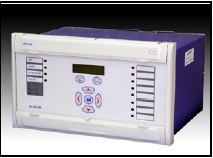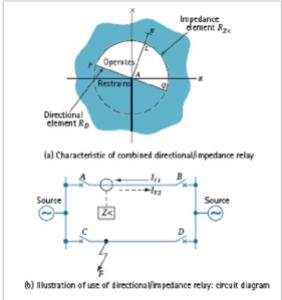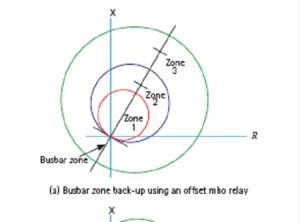Understanding Distance Protection Relay
Distance protection relay- Before going to Distance Protection Relay First see what is Protection System in Power System & Transmission Lines.
- The purpose of protective relays and system is to operate the correct CB so as to disconnect only the faulty Equipment/Ckt. From the system as quickly as possible, Thus minimizing the trouble & damage caused by fault when they do occur.
- Most faults are shunt faults which are characterize by increase in current, reduction in voltage, power factor & frequency.
Primary & Backup Protection
- Primary relaying or also called Group-1, Main-1 or Stage-1, the function of this is first line of defense for protecting the eq. whereas the backup relaying (Group-2, Main-2 or Stage-2) works only when primary relaying fails.
- Time delay and relay settings of backup relays are higher than the primary relays.
- In distance protection Characteristics are also different for both primary & backup relays.
Understanding Distance Protection & distance protection relay
Why Distance Protection
> Since the impedance of a transmission line is proportional to its length, for distance measurement it is appropriate to use a relay capable of measuring the impedance of a line up to a predetermined point (the reach point). Such a relay is described as a distance relay and is designed to operate only for faults occurring between the relay location and the selected reach point, thus giving discrimination for faults that may occur in different line sections.
> The basic principle of distance protection involves the division of the voltage at the relaying point by the measured current. The apparent impedance so calculated is compared with the reach point impedance.
If the measured impedance is less than the reach point impedance, it is assumed that a fault exists on the line between the relay and the reach point. The reach point of a relay is the point along the line impedance locus that is intersected by the boundary characteristic of the relay. Since this is dependent on the ratio of voltage and current and the phase angle between them, it may be plotted on an R/X diagram. The loci of power system impedances as seen by the relay during faults, power swings and load variations may be plotted on the same diagram and in this manner the performance of the relay in the presence of system faults.
DISTANCE PROTECTION RELAY CHARACTERISTICS
Some numerical relays measure the absolute fault impedance and then determine whether operation is required according to impedance boundaries defined on the R/X diagram. Traditional distance relays and numerical relays that emulate the impedance elements of traditional relays do not measure absolute impedance.
They compare the measured fault voltage with a replica voltage derived from the fault current and the zone impedance setting to determine whether the fault is within zone or out-of-zone.
Impedance Characteristics
Relay measuring elements whose functionality is based on the comparison of two independent quantities are essentially either amplitude or phase comparators.
For the impedance elements of a distance relay, the quantities being compared are the voltage and current measured by the relay. There are numerous techniques available for performing the comparison, depending on the technology used. They vary from balanced-beam (amplitude comparison) and induction cup (phase comparison) electromagnetic relays, through diode and operational amplifier comparators in static-type distance relays, to digital sequence comparators in digital relays and to algorithms used in numerical relays.
Plain Impedance Characteristic
This characteristic takes no account of the phase angle between the current and the voltage applied to it; for this reason its impedance characteristic when plotted on an R/X diagram is a circle with its center at the origin of the co-ordinates and of radius equal to its setting in ohms.
Operation occurs for all impedance values less than the setting, that is, for all points within the circle. The relay characteristic, shown in Figure 11.7, is therefore non directional, and in this form would operate for all faults along the vector AL and also for all faults behind the Bus bars up to an impedance AM. It is to be noted that A is the relaying point and RAB is the angle by which the fault current lags the relay voltage for a fault on the line AB and RAC is the equivalent leading angle for a fault on line AC. Vector AB represents the impedance in front of the relay between the relaying point A and the end of line AB. Vector AC represents the impedance of line AC behind the relaying point. AL represents the reach of instantaneous Zone 1 protection, set to cover 80% to 85% of the protected line.
Disadvantages of Impedance Char.
A relay using this characteristic has three important disadvantages:
i. it is non-directional; it will see faults both in front of and behind the relaying point, and therefore requires a directional element to give it correct discrimination
ii. it has non-uniform fault resistance coverage
iii. it is susceptible to power swings and heavy loading of a long line, because of the large area covered by the impedance circle.
Impedance relay with Directional element
- Directional control is an essential discrimination quality for a distance relay, to make the relay non-responsive to faults outside the protected line. This can be obtained by the addition of a separate directional control element.
The impedance characteristic of a directional control element is a straight line on the R/X diagram, so the combined characteristic of the directional and impedance relays is the semi-circle APLQ shown in Figure below:
Mho Relay
The mho impedance element is generally known as such because its characteristic is a straight line on an admittance diagram. It cleverly combines the discriminating qualities of both reach control and directional control, thereby eliminating the ‘contact race’ problems that may be encountered with separate reach and directional control elements. This is achieved by the addition of a polarising signal. Mho impedance elements were particularly attractive for economic reasons where electromechanical relay elements were employed. As a result, they have been widely deployed worldwide for many years and their advantages and imitations are now well understood. For this reason they are still emulated in the algorithms of some modern numerical relays.
- The characteristic of a mho impedance element, when plotted on an R/X diagram, is a circle whose circumference passes through the origin, as illustrated in Figure (b).
This demonstrates that the impedance element is inherently directional and such that it will operate only for faults in the forward direction along line AB.
The impedance characteristic is adjusted by setting Zn, the impedance reach, along the diameter and ϕ, the angle of displacement of the diameter from the R axis. Angle ϕ is known as the Relay Characteristic Angle (RCA). The relay operates for values of fault impedance ZF within its characteristic.
Third zone and bus bar back-up zone
- In this application it is used in conjunction with mho measuring units as a fault detector and/or Zone 3 measuring unit. So, with the reverse reach arranged to extend into the busbar zone, as shown in Figure 11.10(a), it will provide back-up protection for busbar faults. This facility can also be provided with quadrilateral characteristics. A further benefit of the Zone 3 application is for Switch-on-to-Fault (SOTF) protection, where the Zone 3 time delay would be bypassed for a short period immediately following line energisation to allow rapid clearance of a fault anywhere along the protected line.





